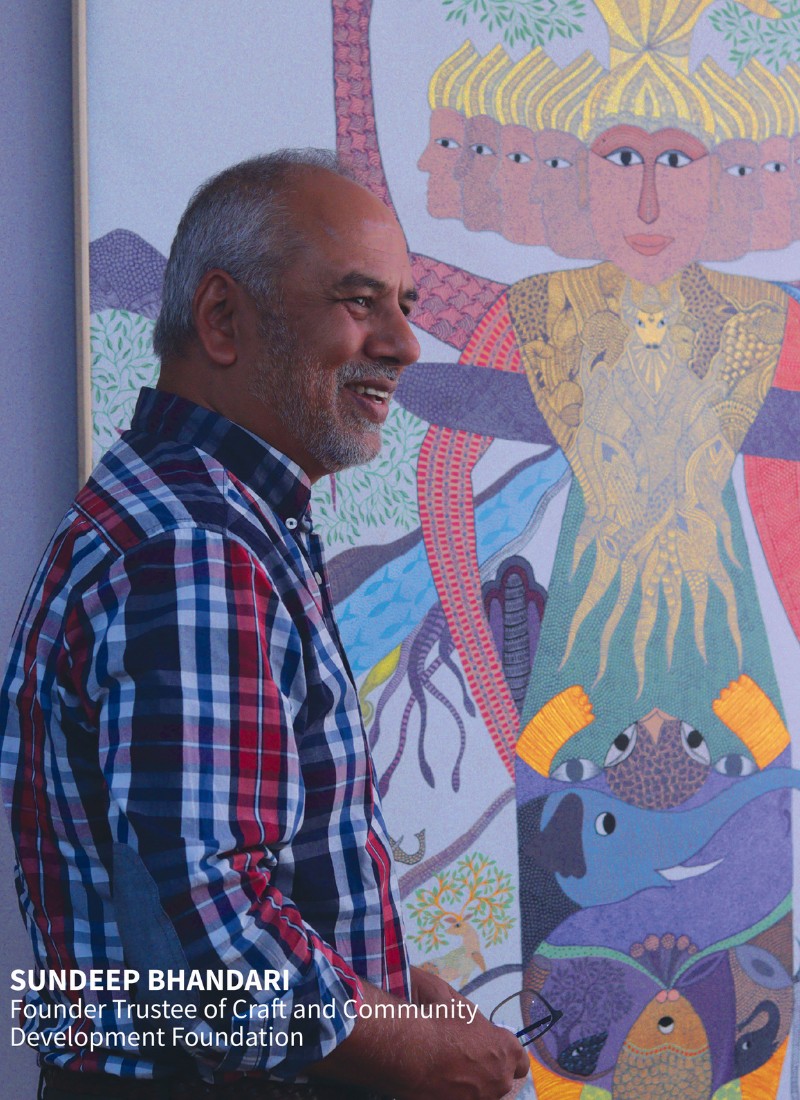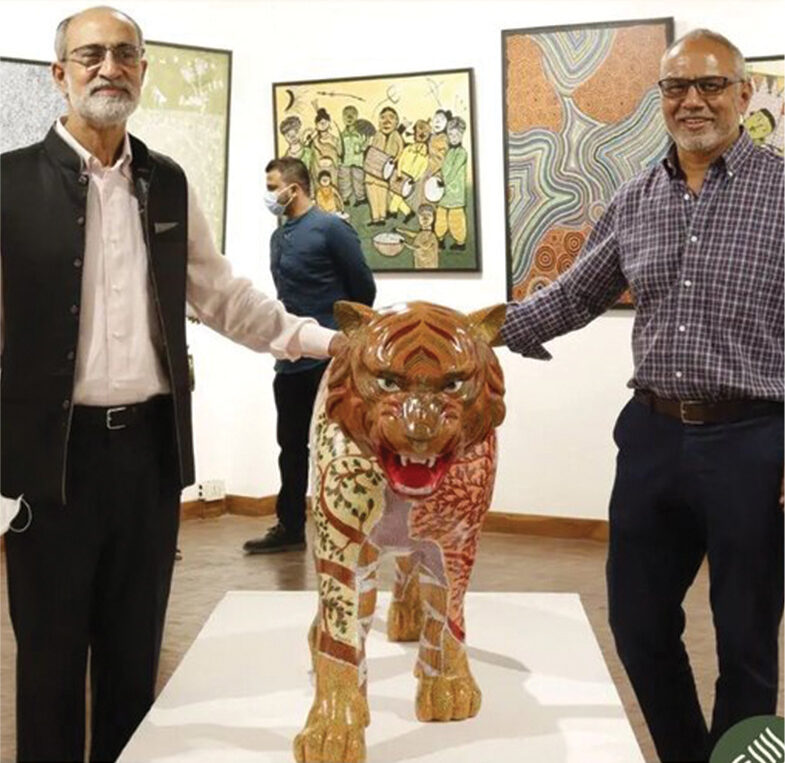The Indian Indigenous Art : From Conservation Pursuit to Contemporary Fineness
Tribal art is filled with history, culture, mythology, it is mostly story-telling that people have been doing through ages.

Whether it is theMandana art by the Meena Tribe of Rajasthan, the Pithora paintings by the Rathwa and Bhil tribes of Madhya Pradesh, or the Bhil paintings done by the Bhil tribes, or the Tanjore paintings from Thanjavur, India is not merely an abode of tribal heritage but a rich menagerie of time-honored tribal art that has continued to carve a distinctive prominence for timelessness and classical Indian identity. Since every piece of art has a story to tell, it is safe to say, that each of us, are individual artist with a piece of life story nurturing the artist in us.
In this edition, MOSAIC brings to you the story of Sundeep Bhandari, who had an established and successful career in oil and gas exploration and production projects in the country and served on boards of public companies. He has undertaken several philanthropic projects and was heading the CSR board of Cairn India Ltd. Sundeep was instrumental in establishing community support and development projects across the country including the Centre of Excellence for Vocational Training in Jodhpur and The Enterprise Centre at Barmer ITI.
Sundeep Bhandari, founder and trustee of the Craft and Community Development Foundation, established the foundation in 2008 with the aim of up-skilling artisans in different fields across India. In the spurring waves of westernization and modernization, Tribal Art is losing its uniqueness, identity, and audience at a pace faster than it can be put into words. In this dark tunnel of time for tribal art, the vision of Gondwana Art people works as a spectrum by providing the tribals a renewed sense of hope on how they can sustain themselves by upskilling and molding their artistic capabilities.

Gondwana Art Project is an initiative whereby they work closely with the tribal population in central India, skilling and mentoring them onglobal connections, new design concepts, and color palettesso that the tribals can support their livelihood in the modern and contemporary era while helping them keep the authenticity of their artforms intact.

When MOSAIC asked Mr. Bhandari why he chose tribal art specifically, he said“Tribal art is filled with history, culture, mythology, it is mostly story-telling that people have been doing through ages. Tribals have excellent skill sets, they do not undergo any formal training, and their practice comes from their forefathers. Also, because Indian tribal art, today, is mostly, restricted to melas, and bazaars, peoplehave started to bracket it as cheap art, many tribal artists,today,lack the requisite support of art galleries, whereby, they could showcase their work globally. Our focus was on how to use their talent, create something out-of-the-box, very contemporary, and still maintain the authenticity of that particular art form. Thus, this is why we choose to focus on promotingtribal art.”
We aim to encourage the tribals, to help them retain the exclusiveness of their distinctive centuries-old heritage and showcase it to the world while ensuring a sustained source of income for them.”
– Sundeep Bhandari
Mr. Bhandari says that tribal people are masters of their art but because of the frequent use of repeated patterns, semi-circles, and geometrical shapes which are a part of their traditional art styles, their artstarted looking very similar, which is why fatigue factor came into being, where people stopped buying their art or started using their art as mere decorative pieces. When asked, what strategy the team at Gondwana Art Project is following one that aims to preserve the tribal art, and develop their skillsets so it becomes more exclusive and commercial for the tribal people. On that, he said that the Gondwana Art team encourages artists to maintain exclusivity and specialization. They try to mentor the tribal artists on new design concepts, for example, directing them to use more global palettes like warm and cool pastels, instead of deep tones. They aim to widen the audience base for theartwork of tribal people. Revisiting his recent successes with different art pieces at Gondwana, he said that in some of their art pieces, they re-make animals, plants, and other creatures from a modern paradigm. Recently many people have approached them to get those art forms for their children, so you see how art can start connecting with an untapped audience, children in this case
Expressing his concernsMr. Bhandari says that today, people are looking to include different pieces of art in their homes, but investing in a beautiful Madhubani or Worli painting is not what they are keen on, since that is what, they have seen at their parents’ home. Also when asked, if they are open to the Gondwana art pieces being transferred digitally into new mediums, into textiles, bags, etc. he said, “We do not want the art to be limited to canvases only, but rather we wish it to move to different mediums, we collaborated with a high-fashion brand for women, they used our artwork as backdrops for the ramp walk.”“Art needs to evolve with the changing times. Gondwana is not pinching pennies or taking a short route. When reviving Warli orMadhubani art, every artwork taken under this project is done differently, in an appreciative and best combination of both heritage and contemporary elements.”

Art has always been known to present an artist’s perspective, but importantly also influences and even undertakes revolutions. When we asked Sundeep how the Gondwana Art Project is using tribal art and its artists as a conduit for promoting sustainability and amplifying its impact on societies? Answering it, the founderreveals that sustainability which includes love and respect for nature, is an inherent aspect of tribal art. For example, tribals have a festival calledCopura, a festival on cattles, where the community gathers, they deck up their cattles with ornaments, and clothes, and one whose cattle looks the best wins the competition. These kinds of festivalsin tribal areas play a significant role in spreading awareness about preserving nature and its elements.He further tells us that, they have discovered some brilliant artists in the course of this project, like Jyoti Vigeh, and Santoshi Shyam. They also worked with the Kurumba artists from Nilgiris. The community was engaged in honey harvesting, and one of the artists from the community curated a painting, that showcased the entire process of honey farming from cultivation to processingon the canvas.
Talking about the upcoming projects at Gondwana Art, Sundeep informsus that they are collaborating with international artists especially contemporary ones, for our tribal art communities to have interactions with them on art and its reception by the art patrons.Gondwana Art Project has their work on display at three different art museums, they are collaborating with an Australian Museum of Art, and an art gallery in Portugal, to showcase their art on a global scale. Also with the renewed interest of people in Indian art and heritage, he is confident that Indian tribal art will soon be at par with global art and Indian indigenous artists will also receive their due as much as native artists of Africa or Australia are given.
“The recurrent boundaries between tribal folk art and modern contemporary styles need to fade.”
– Sundeep Bhandari
